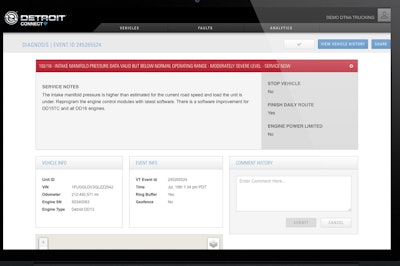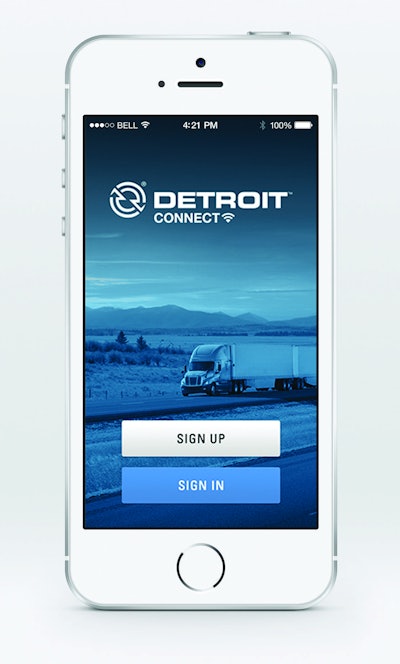 DTNA says the new Detroit Connect portal will allow fleet managers better access and more insights on engine- and truck-related data.
DTNA says the new Detroit Connect portal will allow fleet managers better access and more insights on engine- and truck-related data.Freightliner and Western Star customers with Detroit engines now have access to the Detroit Connect portal, the new online hub for Daimler Trucks North America’s Detroit Connect proprietary connected vehicle solution. DTNA said portal access is available at no cost to customers with active subscriptions to Detroit Connect services, including DTNA’s Virtual Technician remote diagnostics service. A mobile app version of the portal will be released later this year, available on iOS and Android platforms.
Subscribers can use the portal to drill down on specific fault events and access full diagnostic information and real-time fault notifications generated by Virtual Technician, as well as view and archive Detroit Diesel Engine Control (DDEC) reports to better analyze metrics and identify trends.
DTNA says the new portal improves on traditional manual data downloads, local machine-based storage and aggregated data collection. “Having multiple trucks or a large fleet, all those emails coming in, that is a lot of information and it takes time to understand what you need to focus on,” said Lauren Attinasi, DTNA’s connectivity product strategy manager, connectivity. “Using this portal interface will help our customers focus only on the exceptions they need to.”
Owners of the new Freightliner Cascadia tractors equipped with Detroit engines will soon be able to use the portal to remotely access DDEC reports over the air.
“By making DDEC reports available through the Detroit Connect portal, we are eliminating the need for fleets to bring a vehicle into the shop and extract the reports,” said Attinasi. “The remote performance reports will benefit uptime as well as overall vehicle insights.”
The Detroit Connect portal also will serve the forthcoming Detroit Connect Remote Updates over-the-air software updates. Later this year, subscribers also can access Detroit Connect Analytics, a new reporting tool that tracks fuel efficiency analytics and driving habits to help fleet managers to improve productivity and safety.
 A mobile app version of the Detroit Connect portal will be available later this year on iOS and Android devices.
A mobile app version of the Detroit Connect portal will be available later this year on iOS and Android devices.Features on the Detroit Connect Analytics tool include vehicle trip analytics and reporting that automatically uploads data at the end of each trip and identifies significant deviations across the fleet, driver fuel efficiency scoring and fleet fuel use analysis.
The analytics program’s safety reporting feature records and reports safety-related events including hard braking, lane departure and roll stability, and allows user-defined time-based scoring. It also offers fleet safety reporting and a safety event viewer that uses data to identify and display where the safety event trigger occurred and the truck’s last reported location.
The new features on the Detroit Connect platform are another step into the traditionally third-party telematics space, however DTNA says it has no plans to extend its reach beyond vehicle data reporting.
“We do have some overlap in some of our products,” said Matt Pfaffenbach, head of operations for Detroit. We are the best on knowledge of the truck itself, but we are not experts in the fleet management side.”
DTNA said its Detroit Connect platform will have open-platform architecture and will have a software development kit available for application developers.
“There is a lot more opportunity from a third-party perspective, not just Detroit features,” said Greg Treinen, DTNA’s manager of connectivity. “We are able to deliver flexibility to use services to deliver data to our customers that they want in addition to the services that we’ll offer.”












